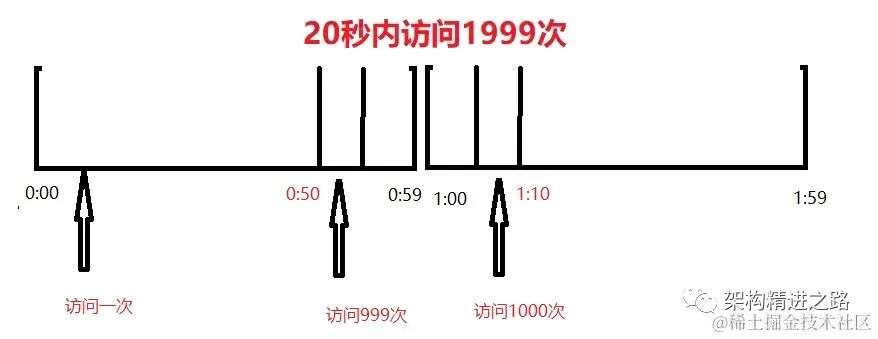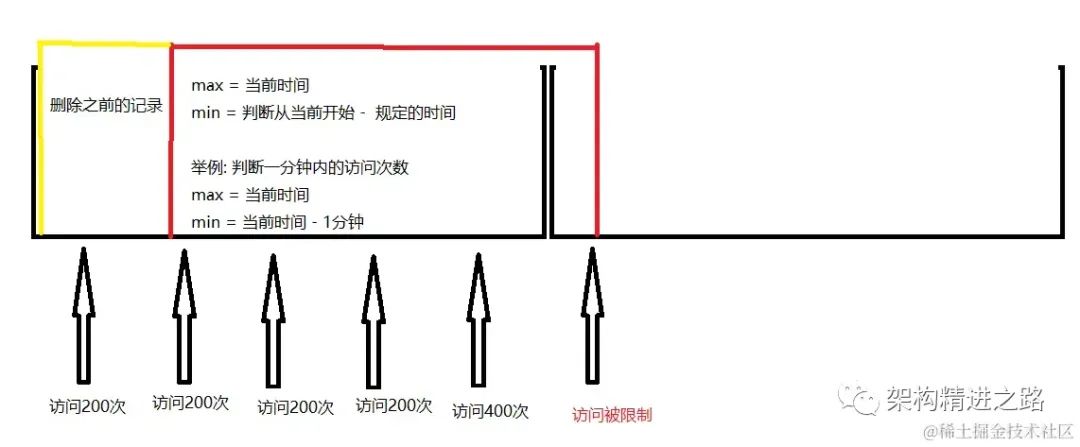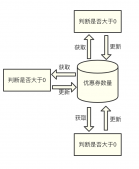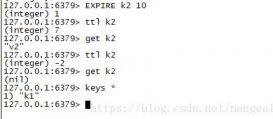简介
市面上很多介绍redis如何实现限流的,但是大部分都有一个缺点,就是只能实现单一的限流,比如1分钟访问1次或者60分钟访问10次这种,但是如果想一个接口两种规则都需要满足呢,我们的项目又是分布式项目,应该如何解决,下面就介绍一下redis实现分布式多规则限流的方式。
思考
- 如何一分钟只能发送一次验证码,一小时只能发送10次验证码等等多种规则的限流
- 如何防止接口被恶意打击(短时间内大量请求)
- 如何限制接口规定时间内访问次数
解决方法
记录某IP访问次数
使用 String结构 记录固定时间段内某用户IP访问某接口的次数
- RedisKey = prefix : className : methodName
- RedisVlue = 访问次数
拦截请求:
- 初次访问时设置 「[RedisKey] [RedisValue=1] [规定的过期时间]」
- 获取 RedisValue 是否超过规定次数,超过则拦截,未超过则对 RedisKey 进行加1
分析: 规则是每分钟访问 1000 次
- 考虑并发问题
假设目前 RedisKey => RedisValue 为 999
目前大量请求进行到第一步( 获取Redis请求次数 ),那么所有线程都获取到了值为999,进行判断都未超过限定次数则不拦截,导致实际次数超过 1000 次
「解决办法:」 保证方法执行原子性(加锁、lua)
- 考虑在临界值进行访问
思考下图
 图片
图片
代码实现: 比较简单
参考:https://gitee.com/y_project/RuoYi-Vue/blob/master/ruoyi-framework/src/main/java/com/ruoyi/framework/aspectj/RateLimiterAspect.java。
Zset解决临界值问题
使用 Zset 进行存储,解决临界值访问问题
 图片
图片
网上几乎都有实现,这里就不过多介绍
实现多规则限流
先确定最终需要的效果
- 能实现多种限流规则
- 能实现防重复提交
通过以上要求设计注解(先想象出最终实现效果)
@RateLimiter(
rules = {
// 60秒内只能访问10次
@RateRule(count = 10, time = 60, timeUnit = TimeUnit.SECONDS),
// 120秒内只能访问20次
@RateRule(count = 20, time = 120, timeUnit = TimeUnit.SECONDS)
},
// 防重复提交 (5秒钟只能访问1次)
preventDuplicate = true
)编写注解(RateLimiter,RateRule)
编写 RateLimiter 注解。
/**
* @Description: 请求接口限制
* @Author: yiFei
*/
@Target(ElementType.METHOD)
@Retention(RetentionPolicy.RUNTIME)
@Inherited
public @interface RateLimiter {
/**
* 限流key
*/
String key() default RedisKeyConstants.RATE_LIMIT_CACHE_PREFIX;
/**
* 限流类型 ( 默认 Ip 模式 )
*/
LimitTypeEnum limitType() default LimitTypeEnum.IP;
/**
* 错误提示
*/
ResultCode message() default ResultCode.REQUEST_MORE_ERROR;
/**
* 限流规则 (规则不可变,可多规则)
*/
RateRule[] rules() default {};
/**
* 防重复提交值
*/
boolean preventDuplicate() default false;
/**
* 防重复提交默认值
*/
RateRule preventDuplicateRule() default @RateRule(count = 1, time = 5);
}编写RateRule注解
@Target(ElementType.ANNOTATION_TYPE)
@Retention(RetentionPolicy.RUNTIME)
@Inherited
public @interface RateRule {
/**
* 限流次数
*/
long count() default 10;
/**
* 限流时间
*/
long time() default 60;
/**
* 限流时间单位
*/
TimeUnit timeUnit() default TimeUnit.SECONDS;
}拦截注解 RateLimiter
- 确定redis存储方式
RedisKey = prefix : className : methodName
RedisScore = 时间戳
RedisValue = 任意分布式不重复的值即可
- 编写生成 RedisKey 的方法
/**
* 通过 rateLimiter 和 joinPoint 拼接 prefix : ip / userId : classSimpleName - methodName
*
* @param rateLimiter 提供 prefix
* @param joinPoint 提供 classSimpleName : methodName
* @return
*/
public String getCombineKey(RateLimiter rateLimiter, JoinPoint joinPoint) {
StringBuffer key = new StringBuffer(rateLimiter.key());
// 不同限流类型使用不同的前缀
switch (rateLimiter.limitType()) {
// XXX 可以新增通过参数指定参数进行限流
case IP:
key.append(IpUtil.getIpAddr(((ServletRequestAttributes) Objects.requireNonNull(RequestContextHolder.getRequestAttributes())).getRequest())).append(":");
break;
case USER_ID:
SysUserDetails user = SecurityUtil.getUser();
if (!ObjectUtils.isEmpty(user)) key.append(user.getUserId()).append(":");
break;
case GLOBAL:
break;
}
MethodSignature signature = (MethodSignature) joinPoint.getSignature();
Method method = signature.getMethod();
Class<?> targetClass = method.getDeclaringClass();
key.append(targetClass.getSimpleName()).append("-").append(method.getName());
return key.toString();
}编写lua脚本
编写lua脚本 (两种将时间添加到Redis的方法)。
Zset的UUID value值
UUID(可用其他有相同的特性的值)为Zset中的value值
- 参数介绍
KEYS[1] = prefix : ? : className : methodName
KEYS[2] = 唯一ID
KEYS[3] = 当前时间
ARGV = [次数,单位时间,次数,单位时间, 次数, 单位时间 ...]
- 由java传入分布式不重复的 value 值
-- 1. 获取参数
local key = KEYS[1]
local uuid = KEYS[2]
local currentTime = tonumber(KEYS[3])
-- 2. 以数组最大值为 ttl 最大值
local expireTime = -1;
-- 3. 遍历数组查看是否超过限流规则
for i = 1, #ARGV, 2 do
local rateRuleCount = tonumber(ARGV[i])
local rateRuleTime = tonumber(ARGV[i + 1])
-- 3.1 判断在单位时间内访问次数
local count = redis.call('ZCOUNT', key, currentTime - rateRuleTime, currentTime)
-- 3.2 判断是否超过规定次数
if tonumber(count) >= rateRuleCount then
return true
end
-- 3.3 判断元素最大值,设置为最终过期时间
if rateRuleTime > expireTime then
expireTime = rateRuleTime
end
end
-- 4. redis 中添加当前时间
redis.call('ZADD', key, currentTime, uuid)
-- 5. 更新缓存过期时间
redis.call('PEXPIRE', key, expireTime)
-- 6. 删除最大时间限度之前的数据,防止数据过多
redis.call('ZREMRANGEBYSCORE', key, 0, currentTime - expireTime)
return false根据时间戳作为Zset中的value值
- 参数介绍
KEYS[1] = prefix : ? : className : methodName
KEYS[2] = 当前时间
ARGV = [次数,单位时间,次数,单位时间, 次数, 单位时间 ...]
- 根据时间进行生成value值,考虑同一毫秒添加相同时间值问题
以下为第二种实现方式,在并发高的情况下效率低,value是通过时间戳进行添加,但是访问量大的话会使得一直在调用 redis.call('ZADD', key, currentTime, currentTime),但是在不冲突value的情况下,会比生成 UUID 好
-- 1. 获取参数
local key = KEYS[1]
local currentTime = KEYS[2]
-- 2. 以数组最大值为 ttl 最大值
local expireTime = -1;
-- 3. 遍历数组查看是否越界
for i = 1, #ARGV, 2 do
local rateRuleCount = tonumber(ARGV[i])
local rateRuleTime = tonumber(ARGV[i + 1])
-- 3.1 判断在单位时间内访问次数
local count = redis.call('ZCOUNT', key, currentTime - rateRuleTime, currentTime)
-- 3.2 判断是否超过规定次数
if tonumber(count) >= rateRuleCount then
return true
end
-- 3.3 判断元素最大值,设置为最终过期时间
if rateRuleTime > expireTime then
expireTime = rateRuleTime
end
end
-- 4. 更新缓存过期时间
redis.call('PEXPIRE', key, expireTime)
-- 5. 删除最大时间限度之前的数据,防止数据过多
redis.call('ZREMRANGEBYSCORE', key, 0, currentTime - expireTime)
-- 6. redis 中添加当前时间 ( 解决多个线程在同一毫秒添加相同 value 导致 Redis 漏记的问题 )
-- 6.1 maxRetries 最大重试次数 retries 重试次数
local maxRetries = 5
local retries = 0
while true do
local result = redis.call('ZADD', key, currentTime, currentTime)
if result == 1 then
-- 6.2 添加成功则跳出循环
break
else
-- 6.3 未添加成功则 value + 1 再次进行尝试
retries = retries + 1
if retries >= maxRetries then
-- 6.4 超过最大尝试次数 采用添加随机数策略
local random_value = math.random(1, 1000)
currentTime = currentTime + random_value
else
currentTime = currentTime + 1
end
end
end
return false编写 AOP 拦截
@Autowired
private RedisTemplate<String, Object> redisTemplate;
@Autowired
private RedisScript<Boolean> limitScript;
/**
* 限流
* XXX 对限流要求比较高,可以使用在 Redis中对规则进行存储校验 或者使用中间件
*
* @param joinPoint joinPoint
* @param rateLimiter 限流注解
*/
@Before(value = "@annotation(rateLimiter)")
public void boBefore(JoinPoint joinPoint, RateLimiter rateLimiter) {
// 1. 生成 key
String key = getCombineKey(rateLimiter, joinPoint);
try {
// 2. 执行脚本返回是否限流
Boolean flag = redisTemplate.execute(limitScript,
ListUtil.of(key, String.valueOf(System.currentTimeMillis())),
(Object[]) getRules(rateLimiter));
// 3. 判断是否限流
if (Boolean.TRUE.equals(flag)) {
log.error("ip: '{}' 拦截到一个请求 RedisKey: '{}'",
IpUtil.getIpAddr(((ServletRequestAttributes) Objects.requireNonNull(RequestContextHolder.getRequestAttributes())).getRequest()),
key);
throw new ServiceException(rateLimiter.message());
}
} catch (ServiceException e) {
throw e;
} catch (Exception e) {
e.printStackTrace();
}
}
/**
* 获取规则
*
* @param rateLimiter 获取其中规则信息
* @return
*/
private Long[] getRules(RateLimiter rateLimiter) {
int capacity = rateLimiter.rules().length << 1;
// 1. 构建 args
Long[] args = new Long[rateLimiter.preventDuplicate() ? capacity + 2 : capacity];
// 3. 记录数组元素
int index = 0;
// 2. 判断是否需要添加防重复提交到redis进行校验
if (rateLimiter.preventDuplicate()) {
RateRule preventRateRule = rateLimiter.preventDuplicateRule();
args[index++] = preventRateRule.count();
args[index++] = preventRateRule.timeUnit().toMillis(preventRateRule.time());
}
RateRule[] rules = rateLimiter.rules();
for (RateRule rule : rules) {
args[index++] = rule.count();
args[index++] = rule.timeUnit().toMillis(rule.time());
}
return args;
}以上,欢迎大家提出意见。















